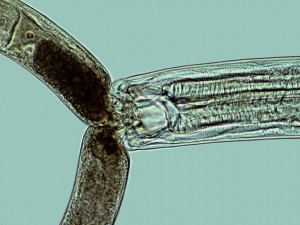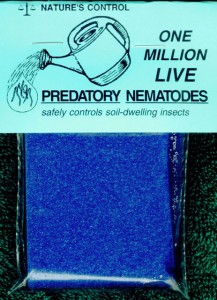Predatory nematodes prove that big scary things come in microscopic packages. These tiny terrors eat other animals and will even resort to cannibalism. Wormlike in appearance, the adults are known as the “double-death” predators. Nematodes control an array of bugs that have life stages in the soil (i.e. beetle larvae). Many of the nematode victims deserve no mercy. Piggish bugs like the cucumber beetle, cutworms, and gypsy moths all deserve the demise delivered by predatory nematodes.

Eat Your Heart Out, Ridley Scott
Some species of predatory nematodes are hermaphroditic with each sex capable of reproduction. The eggs owns a toughness usually reserved for far fetched alien flicks. The eggs can survive freezing and can go without oxygen.

Adults are wormlike in appearance with a transparent body. The intensely curious need only a microscope (and lots of time on their hands) to see what a nematode just ingested.

Soil Saviors
While many nematodes inflict harm on plant (root-knot nematodes), animal (trichina worm), and human (pinworms), predatory nematodes benefit the life cycle typically found on a well-maintained garden or farm. The tiny worms are on a constant hunt for food, wriggling through soil or plants in search of unsuspecting morsels. This persistent movement mixes up the surrounding soil, which keeps the media healthy for the ecosystem.
SpongeBob on Steroids
Predatory nematodes are even more invaluable in the bug control department. Flea infestation in the yard? Set loose some nematodes. Japanese beetles devouring everything including fence posts? Find their larvae in the spring and let the nematodes feast. The best way to have predatory nematodes in your soil is to go through websites like Nature’s Control or go to any of the five Fifth Season stores. The purchased nematodes are typically come on a sponge which you will put into a full watering can. The sponge can be cut in half or more since the whole sponge can treat up to 2500 square feet! Plus, the population of each sponge is a million inhabitants!

Then, it’s as easy as sprinkling the yard or plot with the nematode-rich water. That’s it. The rest is up to (a voracious) nature.

Virginia Gardner says
Can I do this now in preparation for next year (will they survive a central Virginia winter?), or should I wait until Spring?
fifth_season says
The soil temperature needs to be between 55 and 85 degrees and the nematodes should be introduced in the early morning or in the evening since sun exposure will kill them. Late spring and early fall are good times to apply.
jenn - portland, or says
I have mealy bugs in my orchids. Will predator nematodes help me control the outbreak if I continue wiping the plants down?
Brandon Colman says
Mealy bugs are a bane of the horticulturalists existence! My concern with predator bugs is in regards to whether they would stay put after they’ve had a few meals. If you have a greenhouse full of plants, this could be a great option. I would recommend the Mealybug destroyer from Nature’s Control. These can be found at http://www.naturescontrol.com/mealybug.html.
For a smaller space, I would start by spraying with a light solution of isopropyl alcohol. This dissolves the waxy coating that protects the mealybugs from dehydration and other environmental hazards. I have gotten in the habit of following that up around 20 minutes later with a pyrethrin/neem oil application. Finally, I physically remove any mealy bugs with the cottony sacks that contain eggs as they are large and easy to identify. Best luck!
secret sumatra says
Wow! Thank you! I permanently wanted to write on my website something like that.
Can I take a portion of your post to my site?
Holliday, Terry E says
I have purchased this product in the past. Does it kill grub worms? trying to keep the moles away. In the past the grub worms were on the list of insects they could kill, I did not see it this time. thank you
Terry Holliday
ashley says
Hi Terry,
Yes, the nematodes go after many types of insects, and grubs are on the list. The pack we currently carry has two strains of nematodes, including the HB type that specifically goes after the grub. I would suggest waiting until the soil temp comes up just a bit, and suggest applying them in late March or early April.
Thanks!